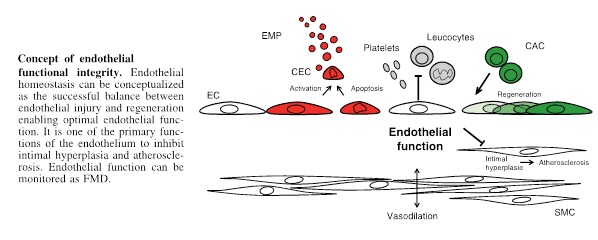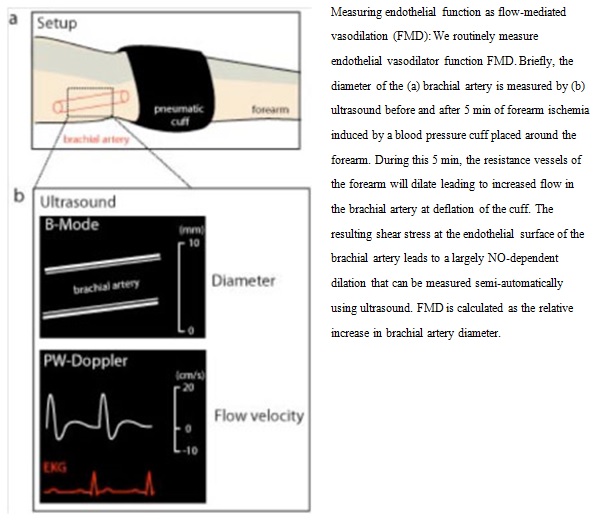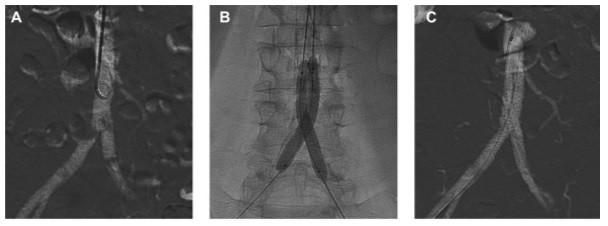Research
Endothelial integrity: a balance of injury and repair
Physiological functions of the arterial endothelium: The arterial wall is composed of cellular and extracellular components. The inner luminal surface of arteries is covered by endothelial cells, while the medial layer is mainly composed of contractile smooth muscle cells. The endothelium controls vascular homeostasis through multiple complex interactions with cells in the vessel wall and lumen. It regulates vascular tone by balancing the production of vasodilators, most importantly nitric oxide (NO), prostacyclin, and endothelium derived hyperpolarizing factor (EDHF), and vasoconstrictors including endothelin-1. The severity of endothelial dysfunction relates to a patient’s risk for experiencing an initial or recurrent cardiovascular event. Our group has previously shown that with increasing numbers of cardiovascular risk factors, endothelium-dependent vasodilation decreases and that this is associated with significantly decreased concentrations of circulating NO adducts that can act as storage forms. A number of interventions known to decrease cardiovascular risk, including diets rich in plant foods, exercise, smoking cessation, weight reduction, medication with angiotensin converting enzyme inhibitors, and statin administration are thought to mediate their vascular protective effect by restoring endothelial function.

Continuous endothelial turnover and regeneration appears to play a central role in life-long maintenance of vascular function and structure. Cardiovascular risk factors may exert their detrimental effects on the cardiovascular system not only by causing endothelial injury but also by interfering with the vascular repair response. One important factor is cigarette smoke exposure. We have previously shown that exposure to second hand smoke can not only acutely injure the endothelium leading to impaired vasodilation but also inhibit the ability of circulating repair cells and endothelial cells to migrate, an important prerequisite for sufficient repair. In a more recent study, we show that the functional reconstitution of endothelial function after catheter induced endothelial damage is impaired in smokers. Furthermore, we have shown that the function of circulating progenitor cells in patients with coronary artery disease is impaired and that this is mechanistically linked to an impaired expression of endothelial nitric oxide synthase (eNOS).

Vascular aging
The causes of aging are still not fully understood. Based on experimental evidence it is widely believed that oxidative stress, accumulation of DNA and protein damage as well as telomere shortening represent key processes that underlie cellular aging. In culture, cells only divide a certain number of times before they go into senescence, which is characterized by permanent mitotic arrest, typical morphology, and cellular dysfunction. Pathophysiologically, many similarities exist between vascular aging and pathological processes that promote arteriosclerosis. We and others have shown in humans and rodents that there is age-dependent endothelial dysfunction, arterial stiffening, and intimal hyperplasia. Importantly, we have shown that an age-dependently decreased function of circulating vascular repair cells is associated with decreased vascular function and intimal thickness. This suggests that age dependent vascular dysfunction may be at least in part secondary to a decreased regenerative capacity of the vascular system. Ongoing studies in our lab attempt to address this important issue.
Bioactives and Vascular Health
Diet is a lifestyle factor that plays a major role in the primary and secondary prevention of several chronic diseases, including certain cancers, coronary artery disease (CAD), stroke, and diabetes. With respect to vascular disease initiation and progression, current dietary recommendations are aimed at optimizing lipid and lipoprotein profiles, blood pressure, blood glucose levels, and body weight. An additional dietary recommendation is to consume more fruits and vegetables. While there is compelling epidemiological evidence that a diet rich in fruits and vegetables lowers the risk of heart disease and stroke, the mechanisms by which these diets mediate their beneficial health effects are unclear. It is reasonable to suggest that they are multi-factorial in nature. For example, fruits and vegetables are typically low in calories and fat, high in fiber, have a favorable sodium/potassium ratio and contain numerous bioactive plant molecules, including group of phytochemicals called polyphenols but also nitrate.
Flavonoids have generated considerable interest as epidemiological studies have suggested an inverse association between the dietary intake of flavonoids and the risk for vascular disease. While the epidemiological findings are provocative, no randomized controlled trials with hard clinical end points have been published that corroborate a cause and effect relationship between the intake of flavanols and vascular health. In our previous studies, we have shown that flavanol rich foods can acutely and chronically improve endothelial function, a surrogate of cardiovascular risk, in healthy subjects and patients with coronary artery disease. We formally linked the acute effects of dietary flavanol ingestion to an enhancement of NO bioavailability. In a more recent study, we provide evidence that the improvement of vascular function following flavanol intervention is related to a mobilization of circulating angiogenic cells. This suggest that flavanols may not only improve endothelial function acutely, but may also improve vascular regenerative processes. Although flavanols are thought to mediate part of their vascular effects by increasing nitric oxide bioavailability, the exact mechanism of action has not been identified so far.
In two recent studies funded by the EU research consortium FLAVIOLA, we have demonstrated that cocoa flavanols improve cardiovascular health and lessen the burden on the heart that comes with the ageing and stiffening of arteries. Earlier studies have shown that cocoa flavanols improve the elasticity of blood vessels and lowers blood pressure in high-risk individuals (smokers and people diagnosed with hypertension and coronary heart disease). These two new studies are first to show that cocoa flavanols can also modulate age-related changes in blood vessels in healthy individuals and may help to prevent the risk of CVD.
In the study published in Age, two groups of young (26 ± 1 y) and older (60 ± 2 y) healthy men consumed either a flavanol-containing drink or a flavanol-free control drink twice a day for 2 wks. Vasodilation (the extent to which blood vessels dilate in response to nitric oxide) was significantly improved (∼30%) in the young and old age groups that consumed flavanols. In the older age group, a statistically and clinically (∼ 4 mm Hg) significant decrease in systolic blood pressure over control was also seen. In the study published in BJN, these researchers extended their investigations to healthy middle-aged men and women (35-60 years, n=100). The participants consumed either a flavanol-containing drink or a flavanol-free control drink, twice a day for 4 weeks. Flavanols significantly increased flow-mediated vasodilation by 21%, decreased blood pressure (∼ 4 mm Hg) and improved blood cholesterol decreasing LDL cholesterol (by 0.17 mmol/L) and increasing HDL cholesterol (by 0.1 mmol/L). Flavanols may reduce the 10-y risk of being diagnosed with CVD by 22% and the 10-y risk of dying from coronary heart disease or CVD by 37% (this Framingham Risk Score estimation must be taken cautiously since the duration of the study and the sample population do not reach the scale of the Framingham studies).
Interventional Vascular Medicine
The clinical research in the context of the interventional Vascular Medicine program has grown substantially over the past years and is now one of the largest in the region. Our patients typically present with co-morbidities in particular chronic renal failure. In a recent study based on the Duesseldorf PTA Registry, we have evaluated the potential with carbon dioxide aided angioplasty to prevent contrast induced nephropathy. Our data clearly support carbon dioxide as an alternative supplemental contrast agent that can be applied safely and efficiently to lower contrast volume during peripheral vascular interventions preventing kidney dysfunction even in patients with disease of the popliteal artery and below the knee and with critical limb ischemia.

Research Methods
There are different ways of translating basic scientific findings into clinical practice and conversely use clinical findings as an inspiration of experimental research. One way is to use one language. This can be achieved by using identical techniques in the different models. Illustrative of this concept, we apply clinical ultrasound techniques (e.g. pulse wave velocity, flow-mediated vasodilation) as used in our patients to rodent models. This approach supplies stronger evidence for causality in scientific conclusions drawn from results obtained in experimental models.
Clinical methods
- Flow-mediated vasodilation
- Venous occlusion plethysmography
- Laser Doppler perfusion imaging
- Pulse wave analysis
- Percutaneous transluminal angioplasty
Rodent models
- Flow-mediated vasodilation
- Laser Doppler perfusion imaging
- Hindlimb ischemia
- Pulse wave velocity
- Closed-chest myocardial infarction
- wire injury
In vitro models
- Primary endothelial and circulating angiogenic cells
- Migration-, chemotaxis-, scratch-, and angiogenesis assays
- Standard biochemical analysis of protein and gene expression
Major Research Interest
- Endothelial Dysfunction
- Vascular Aging & Regeneration
- Nutrition & Bioactives


